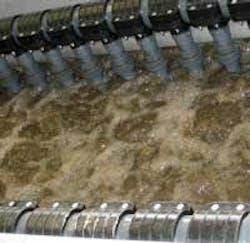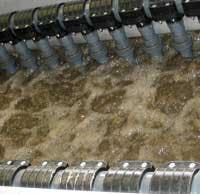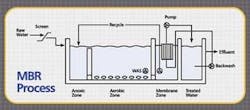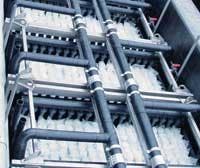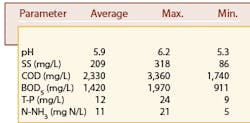New Dual-Stage MBR Technology Yields Higher Quality Effluent at Reduced Operating Costs
By David Pearson
The traditional way to process wastewater generated in food and beverage production, chemical and pharmaceutical manufacturing, pulp and paper processing, metal finishing and steel production has involved an activated sludge process. Wastewater is introduced into a biological treatment tank where organic contaminants are reduced and nutrients removed. The resulting biomass or sludge then flows to a clarifier or settling tank where solids separate out and effluent can be taken off and filtered prior to disinfection. If higher levels of effluent quality are required before disposal or re-use, an additional microfiltration (MF) or ultrafiltration (UF) step may be required.
While simple and economical, the activated sludge approach to treating wastewater also has some drawbacks. First, it's a multi-step process involving primary and secondary clarification, aeration, filtration and disinfection. These plants require a substantial amount of space and are maintenance intense. The resulting effluent product may be clean enough for discharge, but isn't usually suitable for reuse without further membrane filtration.
An alternative technology, membrane bioreactors (MBR), has been receiving increasing attention over the last decade as a direct result of water scarcity and the increasing need to reduce levels of solids and nutrients in effluent to meet more stringent treatment requirements for discharge as well as allow for water re-use. In general, any wastewater source that can be treated using the activated sludge process can be treated using the MBR process.
Until recently, traditional activated sludge processes have been used for most applications because of their relatively low cost. An MBR is less expensive than a conventional wastewater plant with tertiary (gravity) and membrane filtration, which is required to achieve the same finished water quality. In comparison, an MBR plant uses about one-quarter of the space as the conventional treatment plant requires and costs less to build and operate.
How MBR Works
Instead of the settling tank used in an activated sludge process to separate solids from liquid, membrane bioreactors use the physical barrier provided by a UF membrane. The membrane filters out suspended solids, and pathogenic organisms, including Giardia and Cryptosporidium.
Membranes can be retrofit to conventional treatment plants with the membrane suspended in the bioreactor tank. Because they can function at much higher mixed liquor suspended solids (MLSS) levels, they increase output and improve effluent quality. This approach has had good success for over 10 years.
Recently, ITT Industries combined the biological treatment experience of its Sanitaire unit with the membrane filtration expertise of Aquious - PCI Membrane Systems, to design, manufacture and market a Dual Stage MBR system. In the new system, the biological treatment portion of the process is kept separate from the membrane filtration stage. Each stage of the process can then be operated at its optimum condition. Critical parameters such as the air-scouring rate can be controlled discretely to minimize cleaning and power costs. In addition, this configuration provides flexibility that allows standard designs to be tailored to suit the specific requirements of different industrial wastewater types.
The system is a complete and continuous process. It accepts wastewater with high loadings of BOD, suspended solids and other contaminants and yields an excellent quality effluent that can be suitable for direct discharge to surface water bodies (depending on local regulations) and “low grade” re-use applications such as vehicle washing. The water can be further treated with polishing processes (for instance, reverse osmosis) to yield potable or ultrapure water.
Dual-Stage Approach
The advantages of the dual-stage MBR system can be summarized as follows:
• Reliability - Simple-to-operate barrier technology, ensuring consistently high effluent quality;
• Compactness - the intensive nature of the process minimizes space requirements;
• Robustness - resistance to shock influent loads, and
• Economy - advanced aeration and membrane technology minimize power demand.
Biological Stage
High-efficiency diffused aeration technology is incorporated into this stage of the MBR system. The Sanitaire Silver Series II™ aeration diffusers used have been used for years in conventional biological wastewater treatment systems.
As membrane filtration is used instead of gravity settling for solids separation, the activated sludge process can be considerably more intense than is possible with a conventional treatment process. In fact, the MLSS level in a dual stage MBR can be as high as 10,000-12,000 mg/L, which is three to five times higher than that employed in conventional treatment. This higher concentration of biomass provides resilience to changes in influent quality and also greatly reduces the overall plant footprint required. For customers needing to reduce the concentration of nitrogen species and phosphorous, an anoxic zone can be incorporated to provide biological nutrient removal, which reduces the need for chemical precipitation.
Filtration Stage
In the membrane filtration stage of the process, submerged hollow-fiber UF membranes are employed to separate the treated water from the biomass. The membranes operate in the UF spectrum, with a pore size of 0.2 micron, so they provide effluent of a very high quality. The membranes are manufactured from porous polyethersulphone material with a braided reinforcement providing mechanical strength. These features of the unique, patented design significantly improve the membranes’ ability to withstand the MBR's harsh operational environment and thus increase their lifespan. The hollow fiber membranes are free floating at one end and connected to a manifold through which a low vacuum is applied to draw the effluent through the filter. Lateral restraint supports provide further stability for the fiber bundles.
Patented air-scour nozzles within the fiber bundles produce air bubbles that keep the fibers in motion and drive solids from the surface. Periodically, some of the clean filtrate can be backflushed through the membranes to clean them.
Field Experience
The effectiveness of this dual-stage MBR system has recently been proven in multiple pilot scale performance trials conducted on both municipal and industrial waste streams. One project, involving wastewater generated in malted barley production for brewing, is typical. As shown in Table 1, the waste contains moderate levels of BOD and suspended solids.
The pilot trials carried out over several months of operation on-site during late 2004 have given excellent quality treated wastewater as shown in Table 2.
Additionally the treated wastewater turbidity has been consistently below 0.1 NTU and is free of bacteria. These results illustrate the high quality of final effluent that is achievable by a dual-stage MBR system. Trials and further investigations are ongoing with the customer to evaluate potential reuse of this treated wastewater in the process.
Conclusion
The dual stage MBR is designed to have a competitive capital cost and will show a significant lower operating cost when compared to other MBRs currently marketed. Thus, in a typical 20-year life cycle analysis, the cost per 1,000 gallons treated will be lower than other systems.
About the Author:
David Pearson is general manager of Aquious - PCI Membrane Systems, of Milford, OH, which is part of ITT Advanced Water Treatment, a business unit of ITT Industries. The company specializes in filtration systems based on tubular membranes for liquids containing suspended, colloidal or viscous materials. It also supplies spiral-wound or hollow fiber membranes for clean feed streams, and ceramic membranes for applications requiring high chemical compatibility and thermal resistance. With its own membrane manufacturing facility and in-house research and development group, it's able to engineer filtration materials and systems to match customer application requirements. Installation, commissioning, training and technical support services also are available. Contact: 513-575-3500, [email protected] or www.aquious.com.
